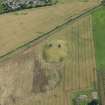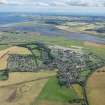Leuchars Castle
Motte (Medieval)
Site Name Leuchars Castle
Classification Motte (Medieval)
Alternative Name(s) Castle Knowe
Canmore ID 33231
Site Number NO42SE 5
NGR NO 45448 21934
Datum OSGB36 - NGR
Permalink http://canmore.org.uk/site/33231
- Council Fife
- Parish Leuchars
- Former Region Fife
- Former District North East Fife
- Former County Fife
NO42SE 5 NO 45448 21934
(NO 4544 2194) Castle Knowe (NR)
Site of Leuchars Castle (Mote) (NR).
OS 6" map (1919).
See also NO42SE 52.
The barony of Leuchars existed in the time of William the Lion (1165-1214), and the castle existed before 1264. It was demolished early in the 19th century.
A H Millar 1895.
Leuchars Castle - the site was originally a mote-hill, with a summit 100 yds long by 60 yds wide and 25ft high, which was later crowned by a stone castle, occupied at least as late as 1565, and part still standing at the close of the 18th century. A moat surrounded the site.
The area is cultivated, and fragments of mortared stone, shell pinnings, glass and tile can be picked up. In 1923 Dr Mears, Leuchars, found a bronze plate just to the S of the mound. It bears figures in 12th/13th century costume, and is now in the National Museum.
RCAHMS 1933, visited 1925.
A portion of a sculptured cross-slab was found on the Castle Knowe, Leuchars - the site of the former Leuchars Castle. There is no masonry left here, and subsequent examination did not lead to the recovery of any other fragments of the slab. The slab, which has been placed in Leuchars Church, may have come from a site near the church where, tradition states, a Celtic chapel (St Bonoc's) was situated.
N M Johnson 1948.
Castle Motte is an oval, flat-topped mound, measuring 100m by 70m by c.8m high. A quantity of building material and oyster shells occurs on the surface, and a number of stone blocks have been placed among two clumps of trees on the mound.
Visited by OS (DS), 19 October 1956.
Leuchars Castle (site) is generally as described above, but cultivation has reduced the summit to about 80.0m N-S by 50.0m.
Revised at 25".
Visited by OS (RDL) 5 June 1964.
Photographed by the RCAHMS in 1978.
What is probably the bailey for this motte has been identified on aerial photographs: see NO42SE 52 for details.
Information from N Cunningham, 1990.
Field Visit (18 September 1925)
Leuchars Castle.
In a low-lying field beside the railway line, 600 yards north of Leuchars Church, is a great oval mound with regularly scarped sides, some 25 feet high and commanded only from the west, where the ground rises to the 50 feet contour. It measures100 yards in length by 60 yards in breadth across the level summit, and is now cultivated, although pieces of stone with mortar, oyster shell pinnings, and fragments of glass and tile can be picked up on the surface, while stones heaped up on the north-east side bear traces of late mediaeval mason work. It is evidently a large mote-hill, later utilised as the foundation of a stone castle, which was occupied at least as late as 1565 (1), and of which part was still standing at the close of the 18th century. It. was then described as "part of an old house, commonly called the castle of Leuchars, built upon a forced bank of earth, on the edge of a swamp, surrounded by a deep and broad moat, inclosing about 3 acres of ground." There was said to be a "draw-well" on the mound, communicating by a "covered drain" with the moat, so that when the moat was drained the well went dry (2).
In a publication of 1723 the castle is described as " the Palace of Leuchers formerly belonging to the Earls of Southesk. . . . There is one apartment of six rooms, with marble chimney pieces, and wainscoted with oak, curiously done, may serve any nobleman" (3).
ENGRAVED PLATE. In 1923 Dr. Mears, Leuchars, discovered on the ploughed land close to and south of the castle mound a thin bronze plate, which had been rolled up. It was found to be circular but much frayed and broken at the edges, with diameters of 11 ½ and 10 ¼ inches (Fig. 332). The centre is occupied by a slightly engraved figure clad in mail and surcoat, the latter descending below the knees. The helmet is flat-topped with a central boss, while the right arm is extended backwards in the act of swinging a sword, in attack upon a monster and a triangular shield is held on the breast. The shield is of medium size and has a boss, from which radiate triple decorative lines. The circumference has apparently been filled in with five similar figures of knight and monster standing outwards, but only the lower parts remain. At various parts of the surface are the capital letters, I.R.A.-N.I.-V.I., some of which are repeated. The costume is of a date in the late 12th or the first half of the 13th century. At some later time the plate had been patched in places. It is now in the National Museum.
RCAHMS 1933, visited 18 September 1925.
(1) See Tomb of Sir Robert Carnegie in No.398 [Parish Church, Leuchars, NO42SE 1.0]. (2) Stat. Acct., xviii (1796), pp. 591-2. (3) A Journey Through Scotland, p. 94.


































